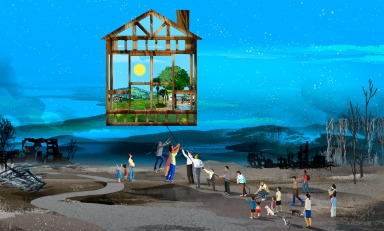New research by an Occidental College biology professor on how the "living rock" cactus protects itself from lethal heat shows how seemingly inhospitable rocky microhabitats will become more important to desert flora as global warming heats up the planet.
The paper, written by professor Gretchen North, also indicates that such hardy plants are already near the limit of their ability to adapt to very high temperatures, which continue to rise.
When growing in rocky soil, the Chihuahuan Desert cactus Ariocarpus fissuratus, a small tan and gray-green succulent that grows flush to the ground, can survive temperatures as high as 140 degrees Fahrenheit by contracting its roots, said North. That's because rocks shield and reflect sunlight away from the cactus and underlying soil, helping to ensure the plant's survival, she said.
In contrast, living rock cacti planted in sandy soil in rooftop experiments conducted at Occidental over two summers died after eight days, researchers found. Fifty percent of the plants' cells were dead when exposed to 134-degree heat, and 80 percent of the cells were dead at 140 degrees.
Cacti in rocky soil contracted between 1/4 inch to 1.2 inches further into the ground to reach soil up to 7 degrees Fahrenheit cooler than that on the surface. The plants did so by compressing the internal tissue in their roots, much like an accordion squeezes together its bellows. North's research was published in the American Journal of Botany in November and was co-authored by two of her former students, Tadao Y. Garrett '08 and Cam-Van Huynh '09.
"A. fissuratus is a great example of life on the edge. But this is a story that may not have a happy ending," North said. "This cactus is operating at its thermal limit, and the projection for the Chihuahuan Desert is that it will be five to 10 degrees hotter by the turn of the next century."
Over the last century, the global average temperature rose by 1.5 degrees Fahrenheit and the Arctic warmed by almost twice as much, according to a recent report by the Pew Center on Global Climate Change
"The higher heat bodes ill not only for A. fissuratus, but also for animals and insects that employ this type of burrowing strategy, like pocket mice, desert toads, and beetles," North added. "One hundred years from now, the populations of these animals, insects, and plants will be smaller."
Other small desert cacti and plants benefit from growing in rocky soil in other ways, North said. A succulent's transpirational water loss is reduced, for example, while its water uptake improves by finding soil more moist than that near the ground's surface.
"As global temperatures increase," she concluded in her paper, "rocky microhabitats will become even more critical refuges for plants such as the living rock cactus."



